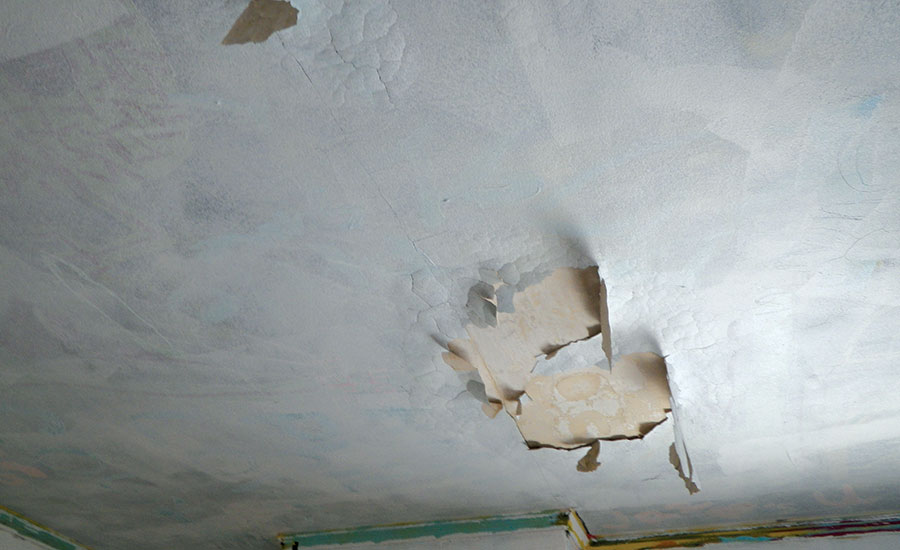The Remediation Trifecta: Mold, Asbestos & Lead Paint
When a mold remediation job grows into a much bigger task










Asbestos jobs do not always start as such. Sometimes, mold in a home leads to bigger discoveries. Conducting mold remediation projects properly is difficult under the best of circumstances. The industry is generally guided by a standard of care rather than strict regulations. While that allows innovation and a multitude of technologies to be used, the current industry guidelines do not agree on universal endpoints to determine when a project has been properly completed. Given this reality for mold remediation, many investigators and contractors who specialize in fungal contamination mistakenly think they are not subject to any regulations. That is a dangerous misconception! Mold remediation professionals who only focus on mold in the structure put themselves at significant personal and legal risk when a project involves more than mold.
One of the worst aspects of having an entire industry operate under an ever evolving standard of care is that individuals working in the industry often forget that a large group of secondary regulations apply to mold remediation work. Contractors have responsibilities under OSHA and EPA regulations to develop and enforce safety programs related to personal protective equipment, respirators, chemicals, waste disposal, electrical equipment, fall protection, and a host of others. Those federal requirements are often supplemented by state and local rules, which also carry the force of law. Two areas where both mold remediation consultants and contractors seem to frequently get in trouble involve missing the regulatory requirements for dealing with asbestos and lead paint.
Asbestos & Lead Regulations
The hazards of exposure to asbestos fibers and lead dust have been well known for decades. At both the federal and state levels, rules dictating specific methods for controlling the dangers to both workers and building occupants are in force. These rules include detailed procedures for conducting inspections and completing work that may disturb the building materials that contain lead or asbestos. Violation of these rules, either intentionally or unknowingly, can result in contamination of an entire structure, as well as heavy regulatory fines. In the case of asbestos, bad work by an inspector or contractor can even lead to citations and fines against the building owner. Such an occurrence often triggers legal action by the client against their own vendor for working outside the law, even though the mold remediation contractor was represented as being a trained professional.
Ignorance of these regulations is no excuse. Nor will the inspector or contractor have an easy go of it if they skip critical steps (such as testing suspect materials or treating certain materials as hazardous) because an insurance adjuster does not consider it a justified cost. Such conversations are analogous to an insurance representative telling a contractor that they do not need to follow the current version of the national electrical code or the plumbing code. Anyone who takes such bad advice almost deserves the trouble they get into, except in cases like these the “trouble” may mean that people’s health has been compromised.
Understanding the Different Approaches of OSHA and the EPA
Mold remediation professionals should be aware that the regulatory environment has changed drastically over the last few years. Gone are the days when contractors would, after being found to be in violation of parts of a rule, get off with a warning or a citation labeled “other than serious”, which usually meant that no penalty was assessed. Now, even paperwork violations that have no direct bearing on the safety of individuals or the environment result in significant fines.
With the implementation of their Renovation, Repair, and Painting (RRP) rules five years ago, the EPA has taken to a new level their enforcement against violators who disturb lead-containing paint. In addition to citations and fines, the agency is publicly shaming individuals and organizations even for paperwork violations by publicizing the citations.
A Mold Project Gone Awry
Some details have been omitted in order to protect the identities of the individuals and organizations involved in this situation.
It is against this regulatory backdrop that I was surprised when I reviewed a recent mold remediation work plan. The homeowner had asked for our assessment of the case when their evaluation of the document was that something didn’t seem right. They were convinced they needed to seek a second opinion when they could not get answers to their questions from the consultant who developed the work plan.
The situation was pretty straightforward. A series of violent storms had damaged the roof and caused water infiltration into the attic and the living areas of the home. A poor response from the restoration contractor (probably because they were under pressure to deal with numerous homes damaged by the storms) allowed water-saturated insulation to sit in the attic for weeks. The resulting mold growth had a decidedly negative impact on the occupants.
The work scope for corrective action indicated the extent of water damage was not confined to the attic, but had found its way into various wall cavities, indicated by visible water staining. This was especially significant since there was an opening several inches wide around the chimney that constituted a travel path all the way from the attic to the basement. In such cases it is important to “chase” the water staining and potential fungal growth by removing surfacing material from ceilings and walls of impacted areas until the entire extent of water damage and fungal growth has been identified and removed.
Even under the best of circumstances, mold remediation work can be difficult. In this particular case the project was complicated by custom textured finish plaster on all the ceilings and many walls. Cutting or further damage to the plaster would have been a nightmare, and attempting to match the intricate patterns in each room impossible. A check of the textured plaster revealed that the material contained 3 percent asbestos—well over the 1 percent threshold for being regulated as an asbestos-containing material by both OSHA and the EPA.
Underestimating Asbestos Contamination
The mold inspector who had prepared the work plan was aware of the asbestos finish materials. However, he had developed a standard mold remediation scope that directed the contractor to make cuts in the ceiling and tops of walls where staining was visible. In an effort to save a few dollars of repair, he had also directed cuts at the bottom near the floor in those areas to see how far the water had migrated. Along with those instructions was a warning about the asbestos and the simple statement that the hazardous material be “handled accordingly”.
What was missed was the reality that the presence of asbestos complicates the mold remediation and repair efforts because any rebuild requires patching into an asbestos-containing material. With surfacing materials that contain asbestos, such as those present on both the walls and ceilings of this residence, this build back creates a “disturbance” of asbestos-containing materials as defined by federal and state regulations. As such, both the initial removal of the sections of drywall specified in the work plan and the later build back would have to be done as asbestos abatement projects. This would require the abatement contractor to be in the house at least twice, rather than dealing with the abatement comprehensively at the very beginning of the project. More important, treating the material in a piecemeal fashion would create additional risks for all of the mold remediation workers involved in the project as their potential for accidently impacting asbestos during their work posed a very real concern.
The suggestion for limited removal of finish materials also ignored the common sense of how such projects really work. If asbestos-containing materials were left in areas that have even minor damage—such as cracks and nail pops—resurfacing of those areas to repair the damage would involve an asbestos abatement contractor. (With this in mind, it is important to note that the initial inspection of the home documented damage to the finish material in most areas of the house.)
The Value of the Comprehensive Approach
Given these circumstances, it was our recommendation that the most economical manner in which to address the removal and replacement of water-damaged/potentially mold-impacted finish material was to implement a full gut of the surface materials in the affected rooms. Approaching it any other way would be time consuming, as the original approach is akin to making “Swiss cheese” cuts throughout the house and then attempting to patch them. Having a licensed asbestos abatement contractor in the structure twice, with isolation barriers and other engineering controls either left in place or reestablished, would be cost prohibitive. Such an approach would also require multiple sets of abatement clearance samples. The suggested work plan did not explain how the patterns of textured material would be seamlessly matched at all of the cut lines.
Another consideration is the long term impact of this approach. Even if the put back could be done safely, proper matching and repainting would then leave the home with a mixture of asbestos and non-asbestos finishes. Since there would be no visible clues to which materials contain the dangerous fibers, future restoration or renovation work could put the workers and occupants at risk due to potential for representative samples being false negatives.
Finally, the work plan was assembled without knowing whether any of the paint in the home contained lead. Because of the structure’s age and high quality construction (before its restriction, the use of textured plaster with asbestos in a home was considered a sign of superior workmanship), the probability of lead in the paint was great. Prior to the 1970’s, leaded paint was known for its durability and was used for both interior and exterior finishes. If any paint in the impacted rooms contained lead, then protective measures for that contaminant would also come into play—another obvious reason why total removal of the finish materials under tightly controlled conditions made sense.
Respect the Wisdom of Contractors
Ultimately, even though our recommendations were rejected by the mold inspector, our suggested approach was validated. In attempting to solicit bids from licensed asbestos contractors, no legitimate firm would bid the work as laid out in the work plan. After seeing the home, they all realized that the “cookie cutter” approach would be extremely difficult to implement properly and would expose them to risk for both short and long term liability. Instead, they offered alternate bids to remove all asbestos materials in rooms where cuts had to be made to accommodate mold efforts.
In this particular case, it was important that the restoration efforts be designed and managed as a comprehensive project rather than a series of sub-tasks. Elevating mold to the predominant position when other regulated hazardous materials were also present was not only pretentious of the mold inspector, but dangerous. Trying to save finish material where multiple sections needed to be removed ignored two of the primary reasons to remove all finish materials in impacted rooms. Without knowing the extent of the water intrusion travel paths and minimizing the regulatory requirements for dealing with finish materials that contain asbestos demonstrated the danger to health and reputation that mold professionals face when they treat all contaminants like they do fungal growth.
In such situations, interior finishes that are known to be contaminated with asbestos (and possibly lead-based paint, as well) take precedence and require abatement by licensed contractors. To do otherwise invites both regulators and lawyers to your door!
Looking for a reprint of this article?
From high-res PDFs to custom plaques, order your copy today!











